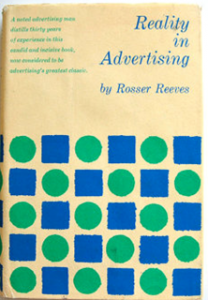Reality in Advertising

– By Rosser Reeves
If you were forced to read just one book on advertising, which one would you go for? I have my shortlist of about five books and, amongst them, one strong contender would be Reality in Advertising by Rosser Reeves. Sadly, the book is out of print although you could, if you are lucky, get a second hand copy from Amazon at a pretty hefty price.
Reeves was the very influential adman of the 1950s/1960s who became the Chairman of Ted Bates. Don Draper, the protagonist in the TV series, Mad Men, is said to have been modelled on Rosser Reeves.
Reeves firmly believed that the purpose of advertising was to sell, a lesson that most advertising people seem to have forgotten. He came out with the popular term – Unique Selling Proposition (USP) – and argued that the job of any advertising was to amplify the USP in as dramatic a manner as possible. The caveat – the brand had to deliver on the USP. He was disdainful of ads that were funny or clever for the sake of it. He was also wary of image advertising and felt that his claim-based advertising would deliver better sales. He was also an opponent of frequent changes in ads. He followed his belief for many of the brands that Ted Bates handled; what is remarkable is that many of them saw a remarkable increase in sales post his advertising campaigns. His ads for Anacin, M&M, Colgate, Minute Maid and Bic are legendary. Even today, Colgate follows his principles in its advertising, likeability be damned!
Reeves was also a strong proponent of honesty in advertising and felt that a product had to be good to sell – no amount of advertising would move inferior products. He felt that while advertising could increase the trial of an inferior product, the dissatisfaction with the product would see its failure.
Reeves’ techniques of the USP and dull, dramatic demonstrations eventually began to grate and consumers shifted their preference to more interesting advertising as amplified by the Volkswagen ads of Doyle Dane Bernbach. However, what should not be forgotten is that ‘positioning’ and ‘value proposition’ are concepts that owe a lot to Rosser Reeves’ Unique Selling Proposition.
When you read Reality in Advertising, some of the ideas may seem out of date; however, many are still very relevant. Let’s look at some of the insights that you will find in the book:
* Unique selling Proposition. Most marketing and advertising professionals must be aware of the USP concept and Reality in Advertising explains how one should do it.
* Penetration and Usage Pull. The measurement of these two would give a marketer an idea of how effective his or her advertising is. These will also give a marketer an idea of how good the competitors’ ad campaigns are.
Reeves describes penetration as the number of people who remember (and who do not remember) your current advertising. Usage pull looks at the number of customers in each group. The difference in these two figures shows how many have been pulled over to the usage of your product by your advertising.
Penetration times the Usage Pull gives you a figure that measures advertising effectiveness.
* Some other insights for advertising effectiveness:
o Stick to a single, strong claim. Consumers tend to remember just one thing from an advertisement – one strong claim, or one strong concept. Be cautious of secondary claims if they suck power from your USP in any way.
o Too-frequent change of your advertising campaign destroys penetration. There is merit in repeating the same campaign (even for decades) as long as it is delivering. A great campaign is unlikely to wear itself out.
o Reach should take precedence over frequency.
o To ensure that the copy is properly communicating the intended USP, test it by asking target consumers to articulate the message, and calculating the percent that get it right.
o Avoid puffery. Avoid visuals and gimmicks that attract attention to them rather than to the USP.
Luckily for all of us, Reality in Advertising is available in pdf format and I have attached the book in one of my posts. The book and its concepts may seem dated (as they are) but they still provide us with some valuable lessons that we may have forgotten. Go through the book – it will be well worth it.
Rating: A
